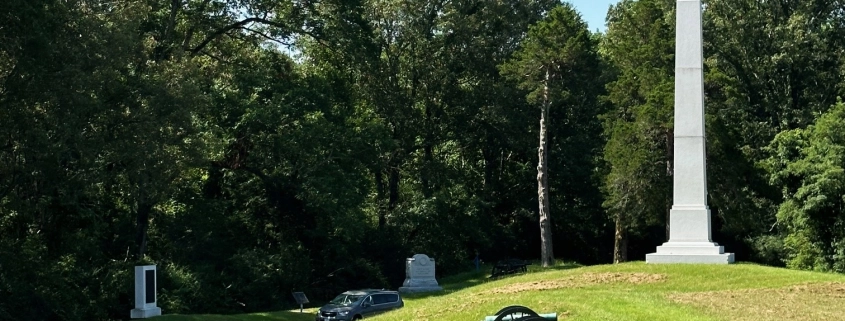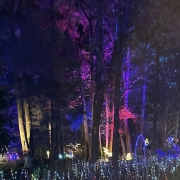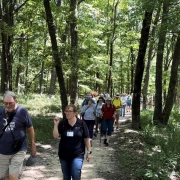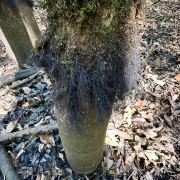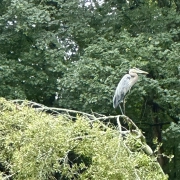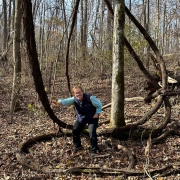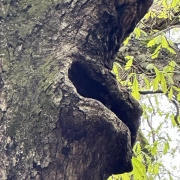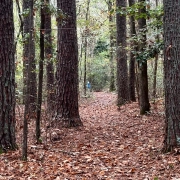Time and Nature Healing Landscape and Spiritual Wounds at Vicksburg, MS
Judy and I visited the Vicksburg, Mississippi National Military Park July 15-17, 2024, with our two Alabama grandsons. I focus this photo essay on Time and Nature healing the landscape and spiritual wounds along the Mighty Mississippi. First and foremost, Nature selected the site for this epic battle. Topographic features along the river proved favorable for highways and railroads crossing the river. The river was and remains one of the nation’s most crucial commerce routes. The intersection of river and ground transportation spurred the birth and growth of the city. Vicksburg is situated on the dryland bluffs overlooking the rich flat delta country. The loess hills on the river’s east side provided a superior location for the city’s fortifications to protect the South’s ground and especially the river lifelines. Rich farmland and bottomland hardwood forests surrounded the city.
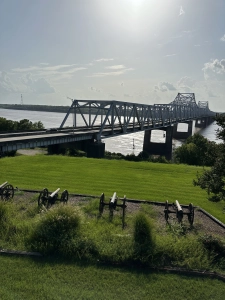
Here is my 59-second video of today’s barge, rail, and highway avenues of commerce.
Jefferson Davis and Abe Lincoln agreed that “Vicksburg was vital to victory” for both sides of the conflict. The armies converged here in the early summer of 1863. I won’t retell the battle. National Military Park literature and countless articles and books are available for historians and interested laymen. The pamphlet I picked up at the visitors center is a good start.
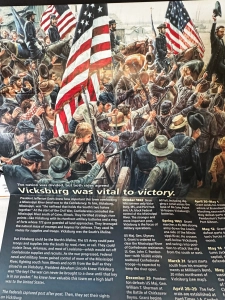
Federal officials established the Vicksburg NMP in 1899, when the land bore fresh battle scars. Nature was reclaiming gullies and canyons with naturally regenerating hardwood forests, a process that early park caretakers encouraged. At the time of the battle and siege, only a few individual trees and isolated groves dotted the hills.
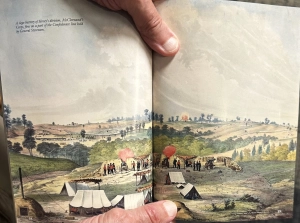
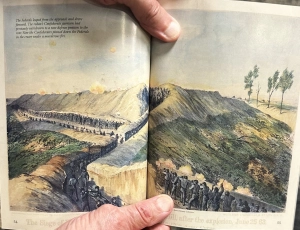
Cannons and marksmen fired across open fields and denuded gorges. Today the ridgelines bordering the maintained meadows and the gorges separating them are forested, masking the killing fields of 1863.

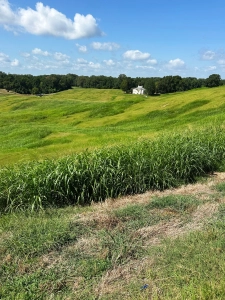
The pleasant aesthetic of pastoral fields and bordering forests is Nature’s healing handiwork, belying the utter starkness and terrifying reality of thousands of enemy combatants face-to-face across open terrain pitted with craters, abandoned and burning materiel, and carcasses of soldiers and horses. Nature began her healing immediately. As John Muir observed so eloquently about Nature broadly:
Nature is always lovely, invincible, glad, whatever is done and suffered by her creatures. All scars she heals, whether in rocks or water or sky or hearts.
He hinted that Nature heals both Earth-scars and injuries of the heart and spirit, which ran deep at Vicksburg and across the perilously divided nation. Twenty thousand dead and wounded during the campaign, and their affected families, exacted a tremendous toll that extended for generations. Many survivors and loved ones attended the 1899 dedication. Tear-filled eyes and yet-aching hearts observed the ceremony.
In contrast, Nature shed no tears on that 36th year following the battle and siege. None of her wounds proved lasting. What permanent harm results from a few hundred tons of lead and explosives? In May of 1980 Mount Saint Helens blew 0.6 cubic miles from her side and reduced tens of thousands of acres of forests to wasteland…land that now supports vigorous regrowing forests. Nature knows calamity, viewing it as a trigger to renewal. Again, what lasting harm results from a few hundred tons of lead and explosives?
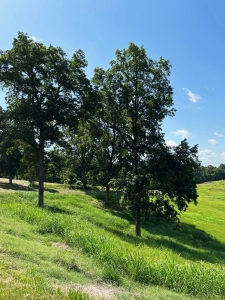
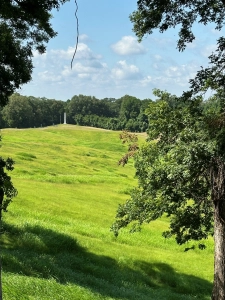
Over 1,400 National Military Park markers and memorials commemorate the engaged individuals and units. Cannons mark the battle lines, hinting at the fiery, deafening, and terrifying fury that prevailed during the extended engagement. I wondered whether any of the combatants gazed into the pastoral future that Park visitors now experience. Perhaps a deep prayer yielded a vision that included warm sun, blue sky, marble monuments, and perpetual peace. As I walked these fields, I felt the presence of the disembodied 20,ooo souls who lost life or limb. I heard them whispering in the treetop breeze.
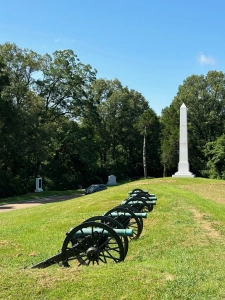
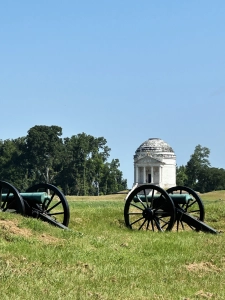
Near those cannons, I recorded this 57-second wide sweep battlefield video:
The iconic Illinois memorial commands a hilltop Union position, providing a sweeping view of a section of still wide open meadow.
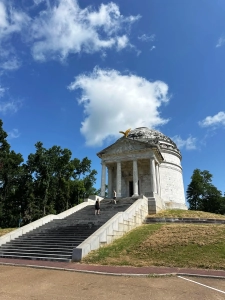
I recorded this 59-second video from the Illinois Memorial:
The ridgeline trees and the forest beyond now frame the memorial. Nature abhors a vacuum; the forest regenerated naturally from the raw abused battlefield.
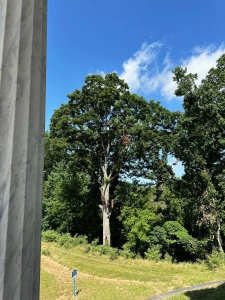
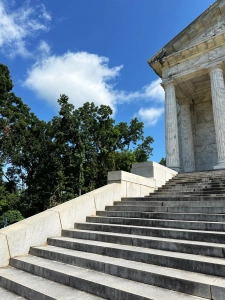
Northwest Corner of the National Military Park
The Mighty Mississippi meanders across its wide delta. Fort Hill, a key Confederate fortress in 1863, stood directly above a broad curve of the river (see the light blue marking its 1863 course). The river now meanders into the eastside bluffs three miles to the south just above the I-20 and rail bridges. Nothing in Nature is static, not even the delta course of the Mississippi River. Were it occupying its current bed in 1863, Fort Hill would have been constructed above the bridge site.
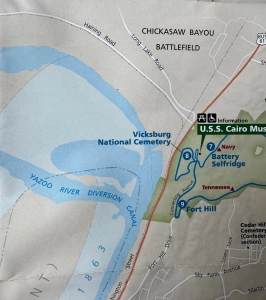
The view at left shows the Yazoo River Diversion Canal from my observation perch near the old Confederate Fort Hill. The canal and adjoining water basin at right occupy the abandoned Mississippi channel. Features of Nature brought the city, its transportation routes, and the two armies to this location. Its ironic that since the epic siege…an encounter that altered the course of US history…the river, without comment or concern, chose an alternate channel on its endless journey to the Gulf of Mexico. Nature, I am certain, cares little for human causes or the passage of time.
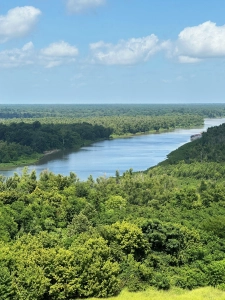
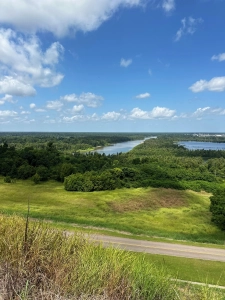
A lonely Confederate cannon reminds us of events here 16 decades ago, long-forgotten by the meandering river.
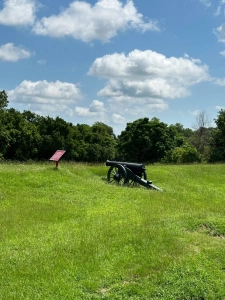
The USS Cairo, a Union wooden-hulled ironclad sunk by two Confederate mines eight miles upriver in December 1862, sits on a concrete platform near its associated museum. Crews lifted the sunken vessel from its 36-feet-deep watery grave in 1964. A National Park Service online reference tells the recovery and display story:
In 1972, the United States Congress enacted legislation authorizing the National Park Service to accept title to the Cairo and reassemble the remnants for display and preservation in Vicksburg National Military Park. Delays in funding halted progress until June of 1977, when the Cairo was returned to the park and partially reconstructed on a concrete foundation near the Vicksburg National Cemetery. The recovery of artifacts from the Cairo revealed a treasure trove of weapons, munitions, naval stores, and personal property that help tell the story of the sailors that once called the ship home. Many of these artifacts are now on display in the USS Cairo Museum.
I find it ironic that the river drawing the combatants to Vicksburg preserved a massive relevant artifact nearby for a century. The river never intended to be an architect or instrument of warfare, a repository for artifacts, or a convener of armies. It’s mission is singular — provide a conduit for the basin’s excess precipitation to reach sea level.
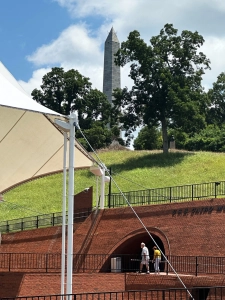
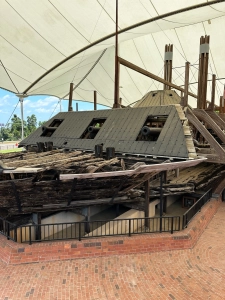
I’ve observed often in these posts that death is a big part of life in the forests where I wander (and wonder). So, too, is death an unfortunate and intentional outcome of warfare. Honoring and memorializing the fallen is an essential component a National Military Park. The Vicksburg National Cemetery serves as a resting place for 17,000 Federal soldiers, of which 13,000 are unknown. Nothing about the Civil War was civil. Many Confederate soldiers are buried in nearby Cedar Hill Cemetery.
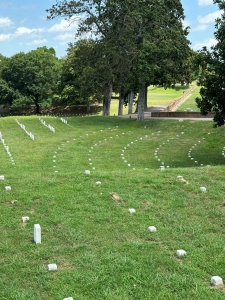
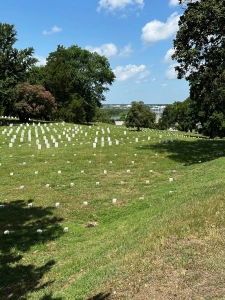
I reflect in my routine photo essays that every tree, every stand, and every forest has a story to tell. Sometimes the secrets are revealed upon examination, stories written in the forested landscape and translated by the astute Nature enthusiast and forensic forest scientist. This cemetery has at least 22,000 stories. I’m reminded of John McCrae’s In Flanders Fields:
Between the crosses, row on row
That mark our place and in the sky
The larks still bravely singing, fly
Scarce heard amid the guns below
We lived, felt dawn, saw sunset glow
Loved and were loved, and now we lie
In Flanders fields, in Flanders fields
To you from failing hands we throw
The torch be yours to hold it high
If ye break faith with us who die
We shall not sleep, though poppies grow
In Flanders fields
I recorded this 58-second video at the cemetery:
The solemnity of the entire Military Park resounds in the cemetery’s quiet beauty and the poet’s voice.
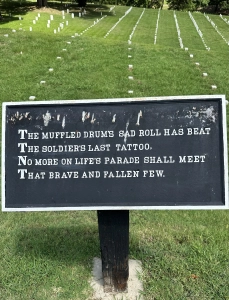
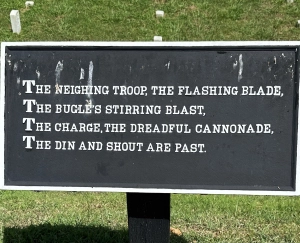
Alabama grandson Sam (10), Jack (16), and Judy pose at our state’s memorial.
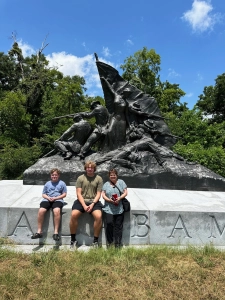
I’ve offered our tour of the Vicksburg National Military Park as one of my photo essays. When I captured on-site images and began writing, I had no clear end destination in mind. However the journey charted its course with just a little navigation by me. Like rain on a hillside, I followed gravity, allowing the essay to seek its sea level.
Albert Einstein, I believe would have agreed:
We still do not know one thousandth of one percent of what nature has revealed to us.
Look deep into nature, and then you will understand everything better.
I don’t claim to comprehend the elements of human and political nature that led to this war, but I contend that understanding the Nature of the location and environs helped me better understand and appreciate the historical moment and the healing consequent to it, both in terms of landscape and spiritual wounds.
Thoughts and Reflections
I offer these observations:
- Look deep into nature, and then you will understand everything better. (Albert Einstein)
- The river never intended to be an architect or instrument of warfare, a repository for artifacts, or a convener of armies.
- Nature is always lovely, invincible, glad, whatever is done and suffered by her creatures. All scars she heals, whether in rocks or water or sky or hearts. (John Muir)
Inhale and absorb Nature’s elixir. May Nature Inspire, Inform, and Reward you!
Note: Unless otherwise noted, all blog post images are created & photographed by Stephen B. Jones. Please circulate images with photo credit: “©2024 Steve Jones, Great Blue Heron LLC. All Rights Reserved.”
Another Note: If you came to this post via a Facebook posting or by another route, please sign up now (no cost… no obligation) to receive my Blog Post email alerts: http://eepurl.com/cKLJdL
And Third: I am available for Nature-Inspired Speaking, Writing, and Consulting — contact me at steve.jones.0524@gmail.com
A reminder of my Personal and Professional Purpose, Passion, and Cause
If only more of us viewed our precious environment through the filters I employ. If only my mission and vision could be multiplied by untold orders of magnitude:
Mission: Employ writing and speaking to educate, inspire, and enable readers and listeners to understand, appreciate, and enjoy Nature… and accept and practice Earth Stewardship.
Vision:
- People of all ages will pay greater attention to and engage more regularly with Nature… and will accept and practice informed and responsible Earth Stewardship.
- They will see their relationship to our natural world with new eyes… and understand their Earth home more clearly.
Tagline/Motto: Steve (Great Blue Heron) encourages and seeks a better tomorrow through Nature-Inspired Living!
Steve’s Three Books
I wrote my books Nature Based Leadership (2016), Nature-Inspired Learning and Leading (2017), and Weaned Seals and Snowy Summits: Stories of Passion for Place and Everyday Nature (2019; co-authored with Dr. Jennifer Wilhoit) to encourage all citizens to recognize and appreciate that every lesson for living, learning, serving, and leading is either written indelibly in or is powerfully inspired by Nature.
I began writing books and Posts for several reasons:
- I love hiking and exploring Nature
- I see images I want to (and do) capture with my trusty iPhone camera
- I enjoy explaining those images — an educator at heart
- I don’t play golf!
- I do love writing — it’s the hobby I never needed when my career consumed me
- Judy suggested my writing is in large measure my legacy to our two kids, our five grandkids, and all the unborn generations beyond
- And finally, perhaps my books and Blogs could reach beyond family and touch a few other lives… sow some seeds for the future
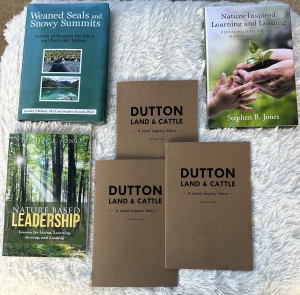
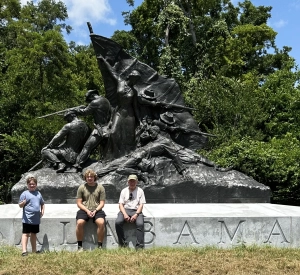
All three of my books (Nature Based Leadership; Nature-Inspired Learning and Leading; Weaned Seals and Snowy Summits) present compilations of personal experiences expressing my (and co-author Dr. Wilhoit for Weaned Seals and Snowy Summits) deep passion for Nature. All three books offer observations and reflections on my relationship with the natural world… and the broader implications for society. Order any from your local indie bookstore, or find them on IndieBound or other online sources such as Amazon and LifeRich.
I now have a fourth book, published by Dutton Land and Cattle Company, Dutton Land & Cattle: A Land Legacy Story. Available for purchase directly from me. Watch for details in a future Post.

